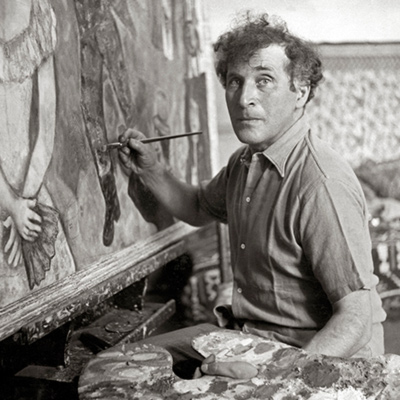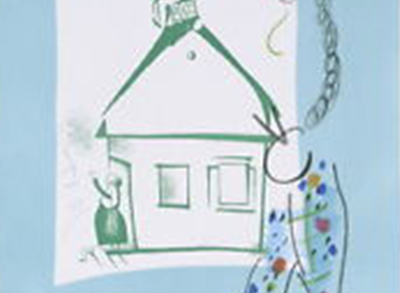
Marc Chagall
On July 7, 1887 in the small Belsrusian town of Vitebsk, Russia, Moishe Segal was born, though the world would come to know him later as Marc Chagall. He was born into a poor Hasidic family of nine children and upon witnessing a fellow student drawing, Chagall began copying pictures out of books and already displaying impressive artistic talent. When he was 20 years old, he moved to St. Petersburg to study art, where his distinctive style influenced by childhood memories already began to emerge. At this time in Russia, Jews were ostracized members of society, and often chose to hide or deny their Jewish heritage rather than endure contempt and criticism. But Chagall chose another route, choosing instead to celebrate and cherish his Hasidic roots through his art. Even in his earliest works, scenes from his village and Jewish themes permeate the spirit of Chagall’s paintings. Decades later, while living in the United States, the artist confirms this in an open letter he wrote to his home village of Vitebsk, explaining, "...I did not live with you, but I didn't have one single painting that didn't breathe with your spirit and reflection." Read More

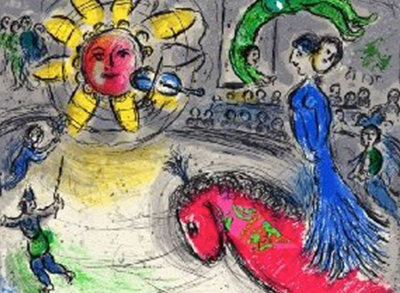
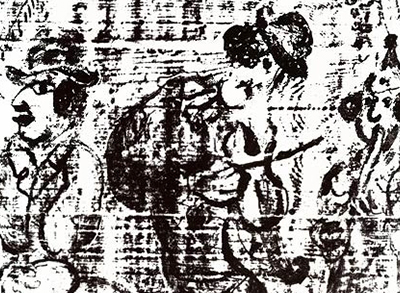
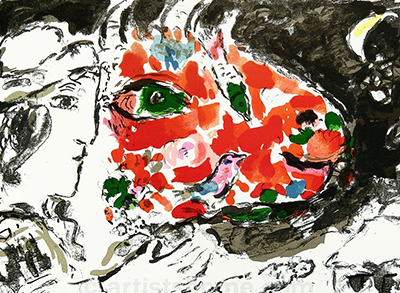
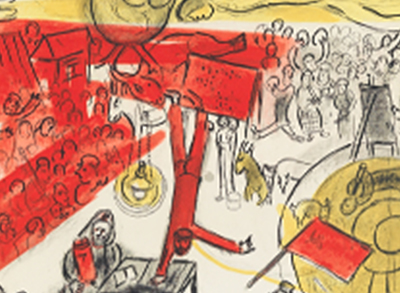

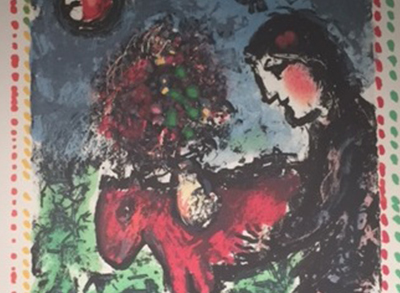
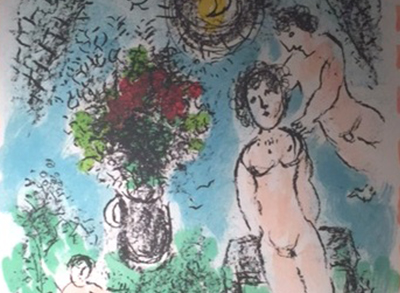
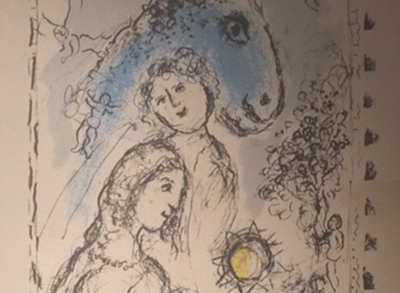

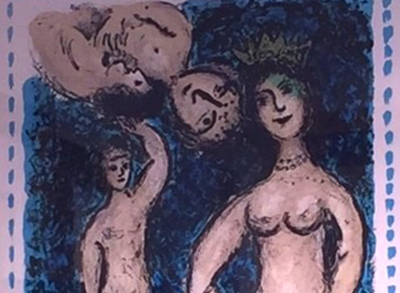

In 1910, Chagall arrived in Paris, awestruck and delighted, and encountered the emerging styles of Surrealism, Fauvism, Suprematism, and Cubism, which continued to shape his work as one of the leading modernists of the time. Though he borrowed inspiration from these progressive art movements, he ultimately rejected their abstract conceptual cores, choosing to remain loyal to the more traditional figurative and narrative art styles. Chagall was more interested in his art embodying poetry, sentiment and humor than trying to adhere to one specific movement’s core ideals, and as a result his earliest recognition came from French poets like Blaise Cendrars and Guillaume Apollinaire rather than fellow painters.
It was during his early years in Paris he painted some of his most famous works and developed the unique style he came to be associated with throughout his career. Homesick for Vitebsk, his family, his native language, and especially Bella Rosenfeld, his fiancee, his art remained true to his heritage, and Chagall found comfort in painting scenes from his Hasidic childhood while in Paris. Vibrant, bold colors, dreamlike figures, non-realistic simplicity, and an air of nostalgia for his Jewish roots displayed often in Chagall’s work effortlessly blended together with the French art styles of the period while retaining a uniqueness independent from any one movement. Sometime in the 1950s, Pablo Picasso remarked that, “When Matisse dies, Chagall will be the only painter left who understands what color really is."
Desperate to get back to Bella in Russia, Chagall found the perfect opportunity to return home when he was honored with his first solo show in Berlin in 1914, which transpired as an enormous success. From Germany he intended to travel back to Vitebsk only long enough to marry Bella before going back to Paris together, but when World War I broke out, Chagall was prevented from returning to France and settled in his hometown of Vitebsk. He married his bride a year later, and they had their first child, Ida. The paintings he completed at this time in his life were remarkably lighthearted, blatantly utilizing motifs of weddings and love to convey his own personal joy. While in his home village, Chagall founded the Vitebsk Popular Art School and served as the school’s director until 1920. It wasn’t until 1923 Chagall returned to Paris, and his first retrospective was held at the Galerie Barbazanges-Hodebert a year later.
As Adolph Hitler began to rise to power in Germany in the 1930s, Chagall and his family were residing in Vichy, France, unaware of the danger they faced as Jews remaining in Europe. It wasn’t until the Vichy collaborationist government began approving anti-Semitic laws which stripped “undesirables” of their French citizenship, that Chagall realized the gravity of their situation. With the help of the U.S. Vice-Consul in Marseilles, Chagall and his family were smuggled out of Europe to New York with the use of forged visas. They narrowly escaped the incoming tides of war and Nazi occupation, and they arrived on U.S. soil only days after Germany invaded the Soviet Union. From 1941-1948 Chagall remained in New York, where he befriended fellow artists and immensely enjoyed visiting the Jewish neighborhoods of the city. Struggling to come to terms with the foundations of the war, especially once his home village was destroyed by the Germans, Chagall’s work began to take on a more serious tone in scenes of crucifixions and battles.
Furthering his grief, Bella died suddenly of a viral infection in 1944, and following her passing, he stopped working altogether for many months. He believed the occupation of Europe had potentially “sapped her will to live”, and Bella took her place in Chagall’s mind alongside the thousands of Jewish victims of the grotesque crimes of World War II. After a year of living with his daughter Ida, Chagall entered into a romance with Virginia Haggard McNeil, with whom he had a son, David, and seven years of happy companionship. After Virginia left Chagall in 1952, his daughter Ida introduced him to Valentina "Vava” Brodsky whom he married and remained with for the rest of his life.
After returning to France in 1948, Chagall began traveling throughout Europe and the Middle East, garnering layers of cultural inspiration for his artwork. During his travels, Chagall found inspiration to delve into new forms of media, experimenting with sculpture in Israel, murals in New York, and stained glass windows for a French cathedral. In 1977, an exhibition of Chagall’s work from 1967-1977 was held at the Musee de Lourve, and he remains one of very few artists to be honored with a retrospective at the museum during his lifetime. Throughout his career Chagall's work, though varied in medium and inspiration, remained fairly consistent in style, and today he is widely known and celebrated for the joyfulness he was capable of bringing to a work through the brilliant use of color, form, and narrative.
Though Chagall died in 1985 at the age of 97—the last surviving master of European modernism--his legacy lives on: In 2010 at a Hong Kong auction, Chagall's Bestiaire et Musique (1969) commanded an exceptional price of over $4 million, becoming the most expensive painting by a modern Western artist ever sold at auction in Asia.

